Expanding efforts to document and understand Great Lakes coregonine river spawning – Year 2
Contributing Authors
Andrew Honsey (USGS, ahonsey@usgs.gov), Todd Hayden (USGS), Ralph Tingley (USGS), Chris David (OMNRF), Tyler Funnell (USGS), Jason Smith (Sault Ste Marie Tribe of Chippewa Indians), Matt Herbert (TNC), Amanda Ackiss (USGS)
Project Description
Restoration and conservation efforts hinge on the identification of key habitats, such as fish spawning habitats (Lewis et al. 1996; Kondolf 2000), and the potentially distinct populations that use them. Knowledge of these habitats can help to ensure that conservation and restoration efforts account for the “three R’s”: representation, resiliency, and redundancy (Shaffer and Stein 2000). Populations that spawn in unique habitats may represent important aspects of diversity (e.g., genetic, phenotypic, behavioral, functional) that are worth conserving. These populations may also contribute to species-wide resiliency to disturbance events, and conserving them or using them for restoration actions (e.g., stocking) can maintain or increase a species’ ability to withstand catastrophic events (i.e., redundancy).
Historically, many Great Lakes coregonines underwent spawning migrations into rivers. For example, spawning was documented or hypothesized to occur upstream or in large river mouths emptying into lakes Huron and Michigan (Madison and Lockwood 2004; Zorn and Sendek 2001). The Niagara River and tributaries in western Lake Ontario provided spawning grounds for cisco Coregonus artedi (Goodyear et al. 1982), and early 20th century creel surveys documented catches of cisco, lake whitefish C. clupeaformis, and round whitefish Prosopium cylindraceum in tributaries of lakes Michigan, Huron, and Superior (Michigan Department of Natural Resources, unpublished data). Contemporary data indicate that connecting waters, including the Detroit and St. Marys rivers, support spawning aggregations of lake whitefish (Roseman et al. 2007) and cisco (Fielder et al. 2000). Finally, the resurgence of lake whitefish spawning in Green Bay tributaries shows that coregonines can re-establish spawning runs in rivers despite a legacy of habitat degradation (Ransom et al. 2021). While few contemporary records of coregonine runs exist in other Great Lakes tributaries, it is likely that the current extent and nature of coregonine river habitat use is underestimated given the challenges associated with sampling during the spawning period (late fall-winter).
This project builds off of work completed in Year 1 (funded in FY22), which involved sampling five rivers across the Great Lakes basin. Work from our first project year resulted in the notable finding of a probable spawning run of cisco in the Spanish River, Ontario, Canada. Specifically, we captured 31 cisco (25 males, 6 females) via night boat electrofishing below the dam in Espanola, ON (~52 river km upstream of the river mouth in the Whalesback Channel) from November 14-16, 2022. All captured individuals were mature and ripe, and they ranged in age from 3-9 yr and total length from 287-394 mm. Most of the captured individuals were morphologically similar to lake spawning cisco populations in the region and conformed to descriptions of “Manitoulin cisco” C. artedi manitoulinus (first described by Koelz, 1929). However, four individuals were morphologically similar to cisco from other regions, including the Les Cheneaux Islands and western Bruce Peninsula (Eshenroder et al. 2021). We are using Genotyping-in-Thousands by sequencing (GT-seq) and low coverage whole genome sequencing (lcWGS) to assess the genetic structure of this population and better understand its potential uniqueness and evolutionary history. To our knowledge, this collection represents the best evidence of cisco spawning in a Great Lakes tributary since the 1880s. These findings are critical for updating our understanding of the ecological (and potential genetic) diversity of coregonines in the Great Lakes and informing conservation and restoration efforts under the Coregonine Restoration Framework (Bunnell et al. 2023). Sampling in other rivers in the first project year resulted in the collection of eight lake whitefish from the Escanaba River, as well as the collection of eDNA samples from the Niagara River (analysis in process). No cisco or other coregonines were captured in the study rivers apart from the Spanish River.
Building off of the success in the Spanish River, we propose to survey three additional Lake Huron tributaries to determine whether coregonines are present in these systems during the spawning period. We will explore the potential for genetic and/or phenotypic differentiation among additional river spawning (if found) and lake spawning populations. In addition, we will use acoustic telemetry to better understand spawning run timing and seasonal movements. This work will improve our understanding of coregonine river habitat use, expand our knowledge regarding the portfolio of coregonine spawning habitats in the Great Lakes, and inform efforts to conserve and restore coregonine diversity both within and between species. This work complements ongoing efforts by co-PIs Smith and Herbert, who have sampled tributaries during the coregonine spawning period annually since 2018; our proposed work will supplement their sampling and allow for genetic analysis of samples collected by their team.
